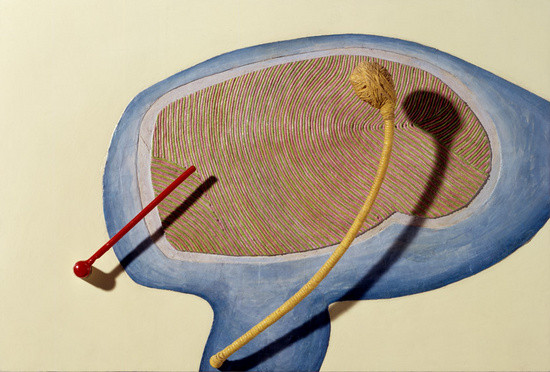Eva Hesse
30 Jan - 09 Mar 2013

Eva Hesse
Legs of a Walking Ball, 1965
Varnish, tempera, enamel, cord, metal, papier-caché, unknown modeling compound, particle board, wood
45.1 x 67 x 14 cm / 17 3/4 x 26 3/8 x 5 1/2 in
Legs of a Walking Ball, 1965
Varnish, tempera, enamel, cord, metal, papier-caché, unknown modeling compound, particle board, wood
45.1 x 67 x 14 cm / 17 3/4 x 26 3/8 x 5 1/2 in
EVA HESSE
1965
30 January – 9 March 2013
In 1964, Eva Hesse and her husband Tom Doyle were invited by the industrialist Friedrich Arnhard Scheidt to a residency in Kettwig an der Ruhr, Germany. The following fifteen months marked a significant transformation in Hesse’s practice. ‘Eva Hesse 1965’ brings together key drawings, paintings and reliefs from this short, yet pivotal period where the artist was able to re-think her approach to colour, materials and her two-dimensional practice, and begin moving towards sculpture, preparing herself for the momentous strides she would take upon her return to New York.
Hesse’s studio space was located in an abandoned textile factory in Kettwig an der Ruhr. The building still contained machine parts, tools and materials from its previous use and the angular forms of these disused machines and tools served as inspiration for Hesse’s mechanical drawings and paintings. Sharp lines come together in these works to create complex and futuristic, yet nonsensical forms, which Hesse described in her writings as ‘...clean and clear – but crazy like machines...’.
Seeking a continuation of her mechanical drawings, in March of 1965, Hesse began a period of feverish work in which she made fourteen reliefs, which venture into three-dimensional space. Works such as ‘H + H’ (1965) and ‘Oomamaboomba’ (1965) are the material embodiment of her precisely linear mechanical drawings. Vibrant colours of gouache, varnish and tempera are built up using papier maché and objects Hesse found in the abandoned factory: wood, metal and most importantly, cord, which was often left to hang, protruding from the picture plane. This motif would reappear in the now iconic sculptures Hesse would make in New York.
The time Hesse spent in Germany amounted to much more than a period of artistic experimentation. In Germany, Hesse was afforded the freedom to exercise her unique ability to manipulate materials, creating captivating, enigmatic works which would form the foundation of her emerging sculptural practice.
‘Eva Hesse 1965’ will be accompanied by a new publication, featuring texts by Todd Alden, Jo Applin, Susan Fisher Sterling and Kirsten Swenson, published by Yale University Press.
1965
30 January – 9 March 2013
In 1964, Eva Hesse and her husband Tom Doyle were invited by the industrialist Friedrich Arnhard Scheidt to a residency in Kettwig an der Ruhr, Germany. The following fifteen months marked a significant transformation in Hesse’s practice. ‘Eva Hesse 1965’ brings together key drawings, paintings and reliefs from this short, yet pivotal period where the artist was able to re-think her approach to colour, materials and her two-dimensional practice, and begin moving towards sculpture, preparing herself for the momentous strides she would take upon her return to New York.
Hesse’s studio space was located in an abandoned textile factory in Kettwig an der Ruhr. The building still contained machine parts, tools and materials from its previous use and the angular forms of these disused machines and tools served as inspiration for Hesse’s mechanical drawings and paintings. Sharp lines come together in these works to create complex and futuristic, yet nonsensical forms, which Hesse described in her writings as ‘...clean and clear – but crazy like machines...’.
Seeking a continuation of her mechanical drawings, in March of 1965, Hesse began a period of feverish work in which she made fourteen reliefs, which venture into three-dimensional space. Works such as ‘H + H’ (1965) and ‘Oomamaboomba’ (1965) are the material embodiment of her precisely linear mechanical drawings. Vibrant colours of gouache, varnish and tempera are built up using papier maché and objects Hesse found in the abandoned factory: wood, metal and most importantly, cord, which was often left to hang, protruding from the picture plane. This motif would reappear in the now iconic sculptures Hesse would make in New York.
The time Hesse spent in Germany amounted to much more than a period of artistic experimentation. In Germany, Hesse was afforded the freedom to exercise her unique ability to manipulate materials, creating captivating, enigmatic works which would form the foundation of her emerging sculptural practice.
‘Eva Hesse 1965’ will be accompanied by a new publication, featuring texts by Todd Alden, Jo Applin, Susan Fisher Sterling and Kirsten Swenson, published by Yale University Press.
